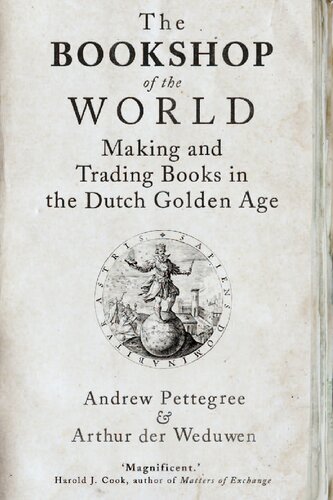1 { When in 1656 Rembrandt was forced to declare bankruptcy, a full inven- tory was made of all of his remaining possessions. Among the paintings, furniture and household goods at the house on the Breestraat, were only twenty-two books. By this time Rembrandt, one of the greatest artists of the age, had fallen a long way. An earlier sale had cleared out most of his art; what remained was the sad residue of a rampageous and self-indulgent celebrity lifestyle. The fact that Rembrandt possessed only twenty-two books, in Amsterdam of all places, was a fitting mark of his near destitu- tion.1 For by this point the Dutch Republic was a land teeming with books. Its publishers produced some of the most fabulous books of the age. More of its citizens read and owned books than anywhere else in Europe. In the seventeenth century, the Dutch published more books, per capita, than any other book-producing nation. True to form, they invented some of the most advanced techniques of the era for selling and marketing print. This was a land where books and reading were integral to the way society functioned, and how people thought of themselves. So it is all the more surprising that books have somehow been written out of the narrative of the Dutch Golden Age. Dazzled by the great Dutch painters, Rembrandt and Frans Hals, the elegant poise of Vermeer and Pieter de Hooch, the grandeur of the landscapes of Jan van Goyen and Jacob van Ruisdael, we seem to have overlooked the quiet revolution going on in the bourgeois home. This was the way in which books were moulding and reshaping Dutch society. It is said that Dutch homes found space for 3 million pictures on their walls. Maybe, but they produced many more books, perhaps as many as 300 million. They traded at least 4 million books at auction
چکیده فارسی
1 { هنگامی که در سال 1656 رامبراند مجبور به اعلام ورشکستگی شد، فهرست کاملی از تمام دارایی های باقی مانده او تهیه شد. در میان نقاشیها، مبلمان و وسایل خانه در خانه بریسترات، تنها بیست و دو کتاب وجود داشت. در این زمان، رامبراند، یکی از بزرگترین هنرمندان عصر، مسیری طولانی را پشت سر گذاشته بود. فروش قبلی بیشتر آثار هنری او را از بین برده بود. آنچه باقی مانده بود، باقیمانده غم انگیز سبک زندگی پرحاشیه و خودخواهانه سلبریتی ها بود. این واقعیت که رامبراند تنها بیست و دو کتاب در همه جا در آمستردام در اختیار داشت، نشانی مناسب از فقر نزدیک او بود.1 زیرا در این مرحله جمهوری هلند سرزمینی مملو از کتاب بود. ناشران آن برخی از شگفتانگیزترین کتابهای عصر را تولید کردند. بیشتر شهروندان آن بیش از هر جای دیگری در اروپا کتاب میخوانند و صاحب کتاب میشوند. در قرن هفدهم، هلندی ها بیش از هر کشور تولیدکننده کتاب دیگری، سرانه کتاب منتشر کردند. درست به شکل واقعی، آنها برخی از پیشرفته ترین تکنیک های عصر را برای فروش و بازاریابی چاپ اختراع کردند. این سرزمینی بود که در آن کتاب و کتابخوانی جزء جدایی ناپذیر نحوه عملکرد جامعه و نحوه تفکر مردم نسبت به خود بود. بنابراین تعجب آورتر است که کتاب ها به نوعی خارج از روایت عصر طلایی هلند نوشته شده اند. به نظر می رسد که ما که توسط نقاشان بزرگ هلندی، رامبراند و فرانس هالز، شیک پوشی ورمیر و پیتر دوهوچ، عظمت مناظر یان ون گوین و یاکوب ون رویسدیل خیره شده ایم، انقلاب آرامی را که در خانه بورژوایی در جریان است نادیده گرفته ایم. . این راهی بود که در آن کتاب ها جامعه هلندی را شکل دادند و دوباره شکل دادند. گفته می شود خانه های هلندی فضایی برای 3 میلیون عکس روی دیوارهای خود پیدا کردند. شاید، اما آنها کتاب های بسیار بیشتری تولید کردند، شاید تا 300 میلیون کتاب. آنها حداقل 4 میلیون کتاب را در حراج معامله کردند
ادامه ...
بستن ...
Author(s): Andrew Pettegree; Arthur der Weduwen
Publisher: Yale University Press, Year: 2019
ISBN: 0300230079,9780300230079
ادامه ...
بستن ...










